Protecting Biodiversity Means Saving the Bogs (and Peatlands, Swamps, Marshes, Fens…)
Wetlands cover just 6 percent of the planet’s land area but provide habitat for 40 percent of wildlife.
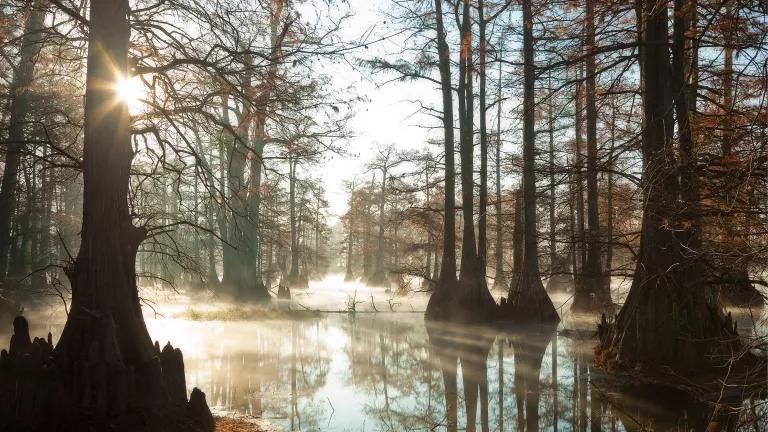
Dawn breaks over a cypress swamp in Arkansas.
Barry Hamilton/Alamy
As it does every year, the U.S. Fish & Wildlife Service (FWS) will be evaluating plant and animal species to determine which ones deserve federal protection under the Endangered Species Act. About half of the species chosen for analysis so far in 2024 have something in common: Their futures depend on the conservation of wetlands.
A mere coincidence? Probably not.
While wetlands cover just 6 percent of the earth’s land surface area, they provide habitat for a whopping 40 percent of plants and animals.
In all likelihood, we can expect this trend of wetland-dependent species coming under the protection of the Endangered Species Act to continue, predicts Amy McNamara, a freshwater ecosystems strategist for NRDC. But this, she says, “is something that we should work to avoid at all costs.” After all, protecting wetlands before its inhabitants are at the edge of extinction would benefit plants, animals, and humans alike.
The importance of wetlands
More than a third of the 1,300-plus plants and animals currently on the Endangered Species list live their entire lives in wetlands. Meanwhile, nearly half of listed species use wetlands as stopover points during migrations. In this way, these areas help connect far-flung habitats to one another, with healthy wetlands in one place being able to give a boost to ecosystems even in other hemispheres. Birds, especially, rely on such stopovers.
“Wetlands and birds are so inextricably linked,” says McNamara. In fact, wetlands serve as homes and migration refueling places to one out of three bird species worldwide. “And up to one-third of North American bird species nest or feed in wetlands.”
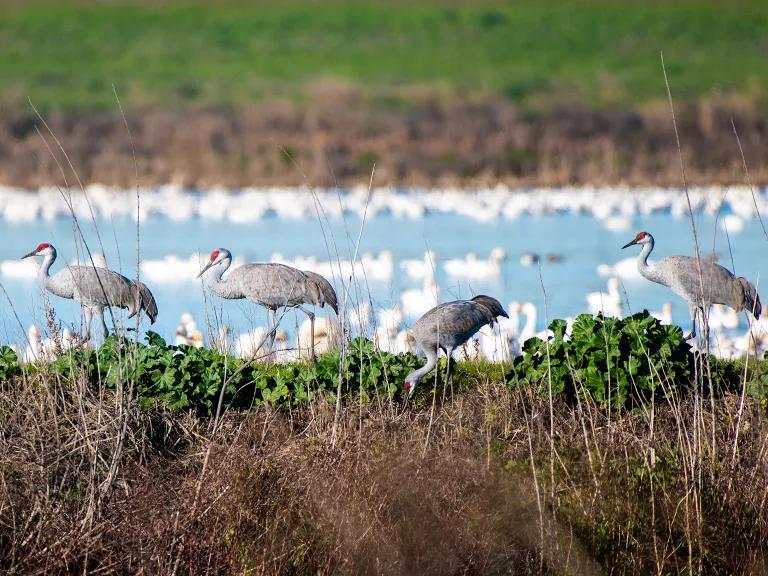
Migrating sandhill cranes stop over in California’s Sacramento–San Joaquin Delta.
Florence Low/California Department of Water Resources
But wetlands provide much more than shelter and nutrition. For instance, while wetlands can offer refuge for wildlife fleeing wildfires, they also slow fires down. And to top it all off, they help filter ash, sediment, and other fire-related contaminants before they wash downstream.
To the list of services that wetlands provide, McNamara adds, “They filter pollution. They filter our drinking water. They’re really critical in absorbing water when it floods.”
What is a wetland, exactly?
Wetlands come in many forms, all of which are important habitats. Coastal saltwater marshes, full of tasty blue crabs and majestic bald eagles, are wetlands, as are freshwater areas, including lakes, ponds, fens, and wet prairies. These types of wetlands tend to teem with waterfowl, cranes, frogs, and turtles galore.
Meanwhile, nontidal marshes are the most prevalent and widely distributed wetlands in North America. They can be deep enough to get your socks wet while wearing knee-high boots or shallow enough to walk through in flip flops.
Some wetlands can also be a bit wishy-washy—here one month and gone the next. Meadows high up in the mountains, for instance, hold surface water when the snow melts, creating high-country habitat for birds, frogs, and occasionally, even beaver and otters. Out on the Great Plains, there are also seasonal prairie potholes and playa lakes that can dry up at certain times of the year.
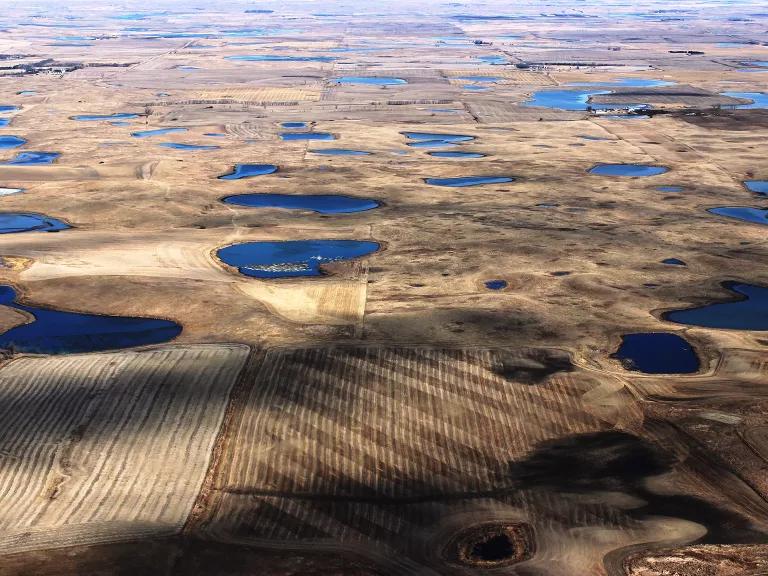
Shallow, ephemeral wetlands dot North Dakota’s prairie pothole region, which is known as the "Duck Factory."
Krista Lundgren/USFWS
There are also riverine wetlands alongside rivers and streams. While humans have sought to tame, tidy, and otherwise obliterate these riparian areas, we do so at our own peril.
But for some reason, something about wetlands seems to give humans the ick. We shudder as the heroes of our stories enter places like the Swamps of Sadness, the Bog of Eternal Stench, and the Fire Swamp. We talk about getting bogged down, in the weeds, or stuck in the mud. And our actions reflect all that anti-wetland mumbo jumbo too.
“Right now, in the continental United States, we’ve already destroyed more than half the wetlands that existed prior to European colonization,” says McNamara. In fact, a 2019 FWS report found that, in just the previous 10 years, the national rate of wetland loss had increased by more than 50 percent.
And we soon stand to lose more. Just last year, the U.S. Supreme Court gutted the Clean Water Act’s wetlands protections. The ruling narrowed the decades-old understanding of which wetlands the act legally protects, delivering a catastrophic blow to any wetlands that don’t connect to other bodies of water at the surface—a decision that runs counter to hydrological science.
“Unfortunately, we tend to think wetlands get in the way of ‘progress’—and I put progress in quotes,” says McNamara. “We have ditched and drained wetlands, and straightened rivers that have historically fed many wetlands. We wrongly view wetlands as a problem that we need to get rid of.”
Wetland species in need of Endangered Species protection
And after centuries of treating wetlands as expendable, the consequences to biodiversity are apparent. Just take a look at some of the latest contenders for the Endangered Species list.
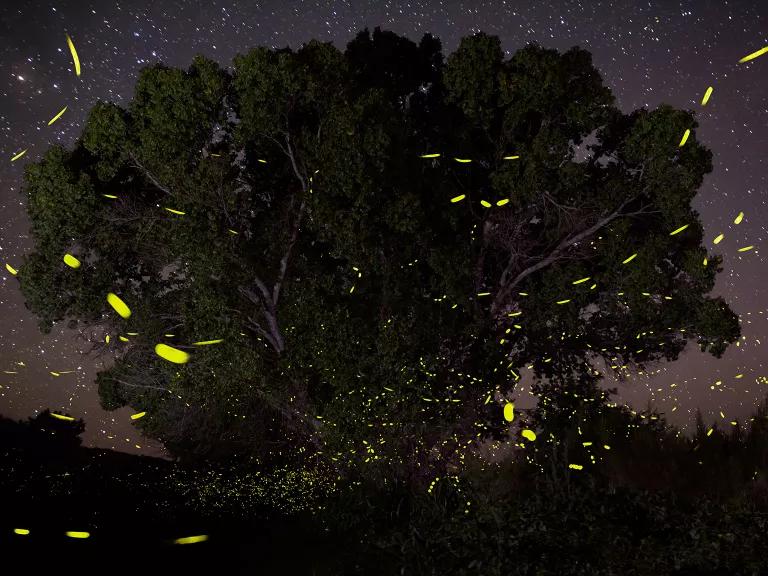
A swarm of Southwest spring fireflies flash in the night sky.
Scott Cylwick
The Southwest spring firefly (Bicellonycha wickershamorum wickershamorum) lights up the night with a series of five green, bioluminescent flashes in a row. Like many firefly species, this beetle can only exist where there are wetlands and riparian areas. One reason for this is, when searching for female fireflies, the males walk, sometimes single file, along the edges of streams, springs, and desert oases called ciénegas.
Climate change, cattle grazing, farming, and light pollution all contribute to the loss or degradation of the firefly’s habitat, threatening its continued existence—matters made worse by the fact that the species is found in just 27 localities in southern Arizona, one of which may already be kaput.
“All firefly species deserve conservation efforts, especially those facing precarious situations or living in niche environments,” says Orit Peleg, a computational biophysicist who studies fireflies at the University of Colorado Boulder. According to the IUCN (International Union for Conservation of Nature), one in three North American fireflies may be in danger of extinction.
Protecting the Southwest spring firefly would also get a lot of conservation bang for the buck, because it would safeguard countless other species that share its habitat.
“The wetland areas we surveyed were captivating,” says Peleg of a study about this firefly that was recently published in the journal Nature. “The environment was alive with the sound of summer insects, frogs, and birds, offering an experience that was both engaging and deeply moving.”
Like the Southwest spring firefly, two species of betta fish (Betta hendra and B. rutilans) are also considered to be umbrella species, which are those whose conservation protects many others in an ecosystem. Native to Indonesia’s peat swamp forests, the bettas are similar to the so-called Siamese fighting fish that are bred for pet stores. Both of these colorful betta species are imperiled in the wilds of Borneo due to logging, fire, and all that comes with the rampant conversion of these forests into palm oil plantations.
But conserving the bettas’ habitats wouldn’t just protect orangutans, clouded leopards, langurs, crocodiles, and pangolins; it’d also go far in the fight against climate change. This is because peat swamp forests sequester vast stores of carbon. In fact, scientists estimate that the habitats of these fish lock up more than 69 billion tons of carbon. To put that figure into perspective, total fossil fuel emissions across the globe in 2023 accounted for 41 billion tons of carbon.
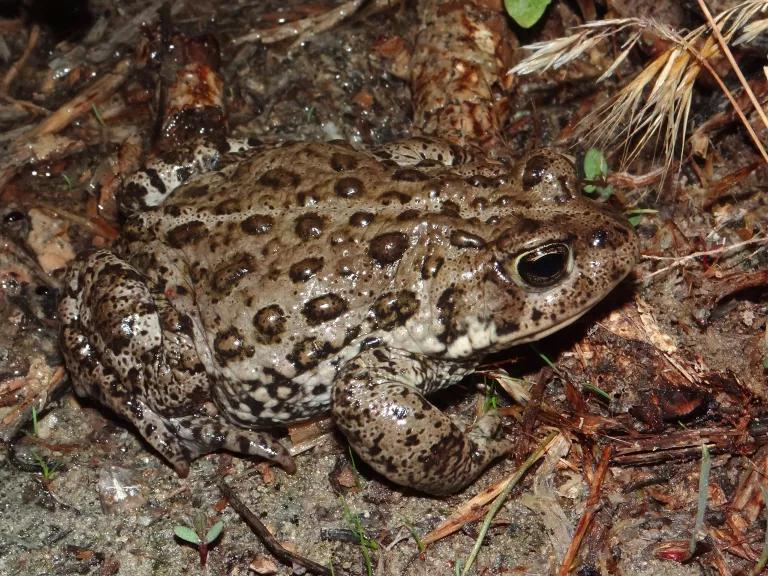
Living in a single wetland complex in Nye County, Nevada, the Railroad Valley toad was only just discovered by scientists in 2020.
Back in the United States, the Railroad Valley toad (Anaxyrus nevadensis) of Nye County, Nevada, is in particularly dire straits. Named after a single wetland complex that’s fed by a thermal spring, the toad was only just discovered in 2020.
“The service determined that threats to the species include oil and gas extraction and groundwater pumping associated with lithium production, which could alter the quantity and quality of spring flow to the wetlands,” says Anne Mankowski, assistant field supervisor for the FWS’s field office in Reno, Nevada.
The amphibian shares its habitat with a federally threatened species known as the Railroad Valley springfish, and research shows that all six of its close toad cousins in the Great Basin region are either imperiled or critically imperiled. While the FWS has yet to fully assess the population, the Railroad Valley toad is certainly not the only rarity hopping around Nevada’s wetlands. And with drought continuing to plague the Southwest, these wet spaces—and the benefits they provide to toads, fish, fireflies, and humans alike—are more precious than ever.
This NRDC.org story is available for online republication by news media outlets or nonprofits under these conditions: The writer(s) must be credited with a byline; you must note prominently that the story was originally published by NRDC.org and link to the original; the story cannot be edited (beyond simple things such as grammar); you can’t resell the story in any form or grant republishing rights to other outlets; you can’t republish our material wholesale or automatically—you need to select stories individually; you can’t republish the photos or graphics on our site without specific permission; you should drop us a note to let us know when you’ve used one of our stories.
How to Become a Community Scientist
Biodiversity 101
Dam Shame